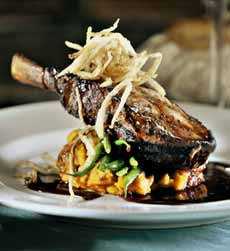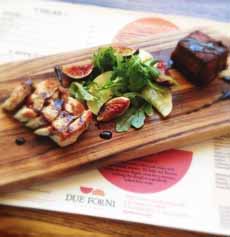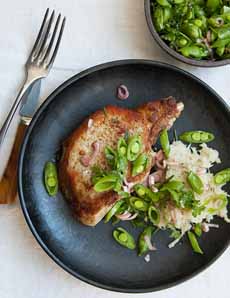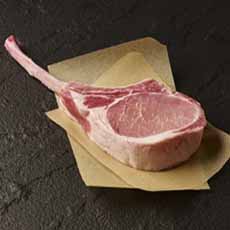TIP OF THE DAY: Finding The Perfect Pork Chop Preparation
|
Growing up, we had pork chops for dinner once a week. Mom pan-fried them with a Dijon glaze, and served them with sides of caramelized onions and her skin-on, chunky mashed potatoes. Caramelized onions mixed into the mashed potatoes, by the way, generates an even better flavor experience greater than eating them separately. Some caramelized onion tips: We don’t often dine at restaurants that have pork chops on the menu; but when we do, we order them. Usually we’re disappointed because they’re: While boneless chops are easier to eat, bone-in chops (and steaks) cook up with more flavor. That’s because the meat close to the bone has more fat, which delivers more flavor. Chefs explain that the bone also engenders a juicier, more tender piece of meat. Plus, you get a bone to gnaw on, if you so desire. According to the National Pork Board, there are five types of pork chops. All are cut from the loin, at the top (back) of the pig: While boneless chops (New York/center cut) are easier to eat, bone-in chops (and steaks, the same for lamb and beef) cook up with more flavor. That’s because the meat close to the bone has more fat, which delivers more flavor. Chefs explain that the bone also engenders a juicier, more tender piece of meat. Plus, you get a bone to gnaw on, if you so desire. Lately, we’ve sliced our way out of the box to try these preparations from Clemens Food Group, via Flavor & The Menu: It’s just two simple steps: 1. MAKE A RUB You can create any rub you like, but here’s one for starters: Combine cardamom, cinnamon, cumin, sweet paprika and turmeric with olive oil. Massage into the pork, then finish with a squeeze of lemon. 2. PICK A CONDIMENT Clemens calls these “flavor boosters,” which is the definition of condiment (actually, see the longer definition below). |
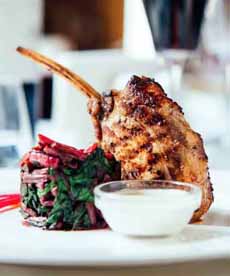 [1] This Frenched pork chop leans against a mound of red Swiss chard. Create the mound by pressing the cooked chard into a food ring (photo courtesy Clemens Food Group).
|
|
|
While conventional practice is to place the sauce on top of the protein, we prefer these options: A condiment is an auxiliary food product that puts spark into food. It is a spice, sauce*, or preparation (chutney, horseradish, ketchup, mustard, relish, salsa, etc.) that is served with food to enhance its flavor. There are sweet condiments, too. For example, fudge sauce, marshmallow creme, sprinkles and whipped cream ice cream make a plain scoop of ice cream taste better. The word is first found in print in French around 1420, and descends from the Latin condimentum, spice, which sprang from the verb condre, to season. Condiments add an easy flourish to the most basic foods. They can transform an everyday ham sandwich or roast chicken into something special (use some of those caramelized onions!). Condiments are also evidence of pervasive fusion cuisine at its best. Indian chutneys, French mustards, Italian pestos and Spanish salsas, to name just a few, are often paired with American dishes from eggs, roasts, salads, and sandwiches to desserts with crème anglaise from the U.K., dulce de leche and red wine sauce from Italy and rose water from Turkey. ________________ *Kurobuta is a Japanese name for a certain quality of pork, from a certain breed of pig: the black pig. In the U.S., that pig is called the Berkshire, a heritage breed. Kurobuta is a higher quality than generic Berkshire. While all Kurobuta pork comes from Berkshire pigs, not all Berkshire pigs are Kurobata grade. |
||
